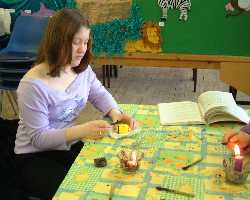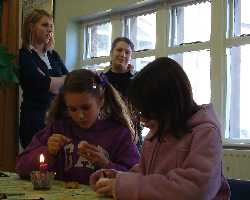|

Pysanky
Ukrainian Easter is a season rich in traditions and one of the most creative of these is the decorating of eggs with patterns and colours – pysanky – and the sharing of pysanky with family and friends. In Ukraine, pysanky were made by the women in the family in the week leading up to Easter. The patterns and symbols on pysanky have special meanings, as do the colours on the eggs, and these had to be carefully chosen depending on the recipient.
 The patterns are drawn on the egg with wax; the wax protects the covered areas from dye that the egg is dipped in. This process is repeated with different coloured dyes and thus a multi-coloured pattern is made up on the egg. Finally the wax is removed to reveal the pattern.
The patterns are drawn on the egg with wax; the wax protects the covered areas from dye that the egg is dipped in. This process is repeated with different coloured dyes and thus a multi-coloured pattern is made up on the egg. Finally the wax is removed to reveal the pattern.
The true origin of pysanky is not known. In pre-Christian times, people who lived in the area of Ukraine worshipped the sun. They saw parallels between the sun and the egg, where by the yolk represented the sun and the white the moon, and thus the egg was used in sun worshipping ceremonies. The egg also became a symbol of life: in winter the Earth lay dormant, just as the egg appeared to have no life; in spring when nature awoke and the Earth blossomed, the egg also hatched a new life.
 When Christianity was accepted in Ukraine in 988AD, the egg was adopted as a religious symbol of the Easter celebration; it is the first item of food eaten on Easter morning to break fast or Lent. The egg was likened to the tomb from which Christ arose and thus pysanky have a very special, religious significance.
When Christianity was accepted in Ukraine in 988AD, the egg was adopted as a religious symbol of the Easter celebration; it is the first item of food eaten on Easter morning to break fast or Lent. The egg was likened to the tomb from which Christ arose and thus pysanky have a very special, religious significance.
The patterns found on pysanky have been handed down between generations, thus preserving this Ukrainian tradition. Many of the symbols found on pysanky date back to pagan times, but with the advent of Christianity in Ukraine they were given Christian meanings, for example, lines circling the egg are endless, having no beginning or end, therefore symbolising eternity or eternal life; crosses represent the suffering, death and Resurrection of Christ; a design incorporating forty triangles is often seen on pysanky – these can represent forty days of Lent or the many tasks of life; birds represent fertility, happiness and fulfilment; horses, deer and reindeer symbolise prosperity and wealth.
 Pysanky are traditionally colourful objects and the colours are also symbolic, for example, white represents purity and innocence; orange – strength, endurance and ambition; black is often used on pysanky decorated for older persons or in memory of the dead, therefore symbolising remembrance.
Pysanky are traditionally colourful objects and the colours are also symbolic, for example, white represents purity and innocence; orange – strength, endurance and ambition; black is often used on pysanky decorated for older persons or in memory of the dead, therefore symbolising remembrance.
Easter signifies the Resurrection of Christ and brings with it the meaning of hope and the emergence of new life. By decorating eggs with Christian symbols and sharing pysanky with family and friends, we are able to share with them these feelings of joy and hope.
As part of the CYM curriculum in Bradford, every year as Easter approaches, sumivti take part in the Ukrainian tradition of decorating pysanky. With the instigation of the Bradford CYM website, this year we are pleased to have this opportunity to show our young sumivti at work on their very own pysanky.
 |



